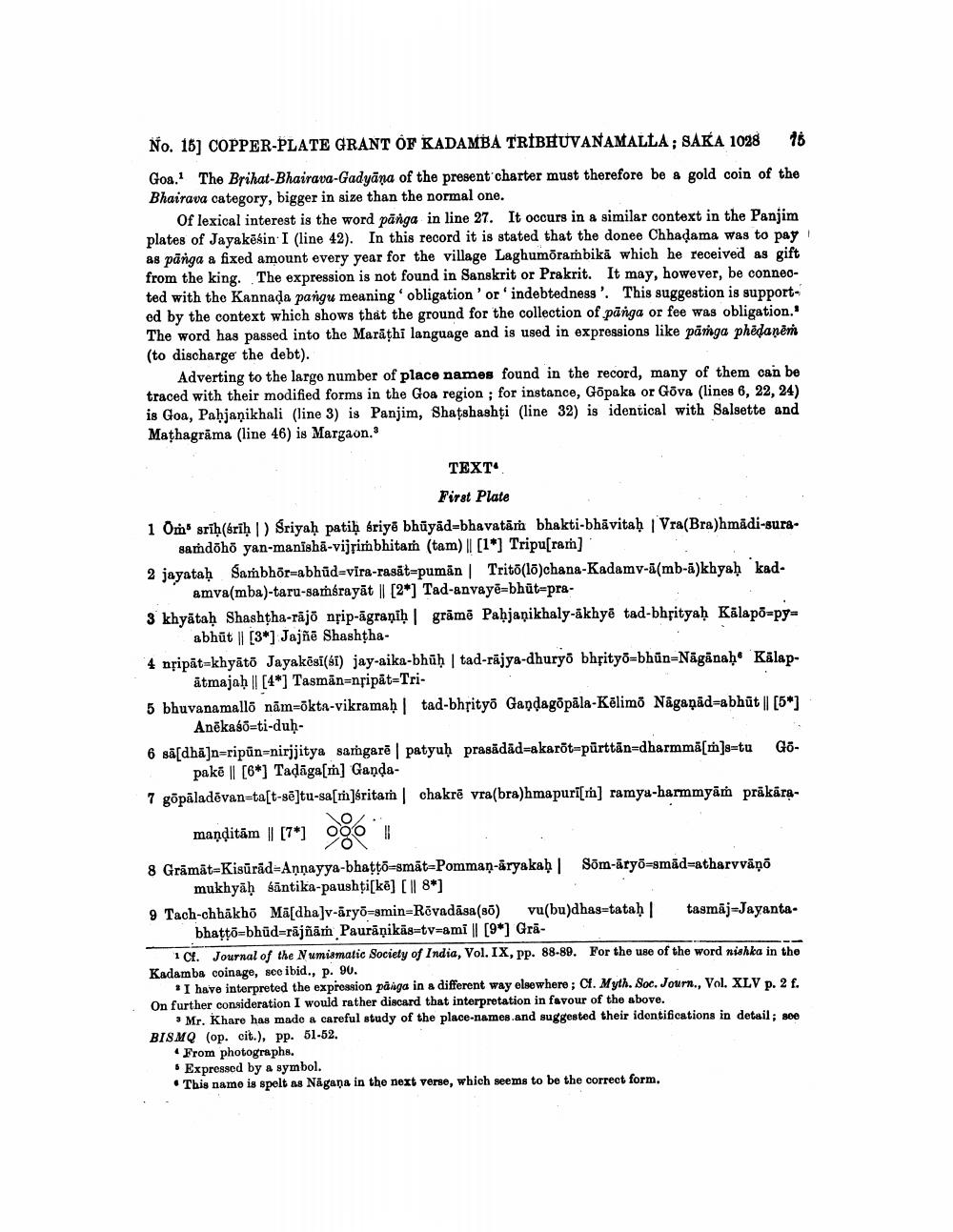________________
No. 15) COPPER-PLATE GRANT OF KADAMBA TRIBHUVANAMALLA ; SAKA 1028
76
Goa. The Brihat-Bhairava-Gadyana of the present charter must therefore be a gold coin of the Bhairava category, bigger in size than the normal one.
Of lexical interest is the word pānga in line 27. It occurs in a similar context in the Panjim plates of Jayakēsin I (line 42). In this record it is stated that the donee Chhadama was to pay as pānga a fixed amount every year for the village Laghumõrambikä which he received as gift from the king. The expression is not found in Sanskrit or Prakrit. It may, however, be conneoted with the Kannada pangu meaning obligation' or ' indebtedness'. This suggestion is supported by the context which shows that the ground for the collection of pānga or fee was obligation.' The word has passed into the Marathi language and is used in expressions like pānga phêdanên (to discharge the debt).
Adverting to the large number of place names found in the record, many of them can be traced with their modified forms in the Goa region ; for instance, Göpaka or Göva (lines 6, 22, 24) is Goa, Pahjaņikhali (line 3) is Panjim, Shatshashti (line 32) is identical with Salsette and Mathagrāma (line 46) is Margaon.
TEXT
First Plate 1 Omsrīḥ(brīḥ) Sriyaḥ patiḥ briyê bhūyäd=bhavatām bhakti-bhävitaḥ Vra(Bra)hmădi-sura
samdoho yan-manīshā-vijfimbhitam (tam) || [1*] Tripu[ram] 2 jayataḥ sambhor=abhūd=vira-rasāt=pumān Trito(lo)chana-Kadamv-ā(mb-ā)khyaḥ kad
amva(mba)-taru-samśrayāt || [2*] Tad-anvay?=bhüt-pra3 khyātaḥ Shashtha-rājö nsip-āgraṇiḥ | grāmē Pahjaņikhaly-ākhyē tad-bhrityaḥ Kõlapā=py
abhūt || [3*] Jajñē Shashtha4 ntipāt-khyāto Jayakēsi(si) jay-aika-bhūḥ / tad-rājya-dhuryo bhfityö=bhūn=Nägänah Kālap
ātmajaḥ || [4*] Tasmān=nfipāt-Tri5 bhuvanamallo nām-okta-vikramaḥ tad-bhrityö Gandagõpāla-Kėlimo Nägaņād=abhūt || [5*]
Anēkaso-ti-duh6 sā[dhā]n-ripūn=nirjjitya sargarē patyuḥ prasādād=akarot-pürttān=dharmmă[m]s=tu Go
pake || [6*] Tadāga[m] Ganda7 gõpāladevan=ta[t-sē]tu-sa[m]britam | chakrē vra(bra)hmapurī[m] ramya-harmmyām prākāra
maņditām || 0 8 Grāmāt=Kisūrād=Annayya-bhattā=smāt-Pomman-aryakaḥ| Sõm-āryā=smād-atharvvāņā
mukhyāḥ sāntika-paushți[kē] [ || 8*] 9 Tach-chhākho Mā[dha]v-āryõ=smin=Rēvadāsa (87) vu(bu)dhas=tataḥ| tasmāj-Jayanta
bhattā=bhūd=rājñām Paurāņikās=tv=ami || [9*] Grā1 C4. Journal of the Numismatic Society of India, Vol. IX, pp. 88-89. For the use of the word nishka in the Kadamba coinage, scc ibid., p. 90.
I have interpreted the expression pānga in a different way elsewhere; CF. Myth. Soc. Journ., Vol. XLV p. 2 f. On further consideration I would rather discard that interpretation in favour of the above.
Mr. Khare has made a careful study of the place-names and suggested their identifications in detail; se BISMQ (op. cit.), pp. 51-52.
From photographs. • Expressed by a symbol. • This name is spelt as Nägana in the next verse, which seems to be the correct form.




